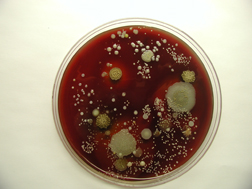Sorry for the hiatus from posting, but I'm pleased to have some good news for once - the experimental antibiotics we've been trying are working beautifully. Due to company policy, I unfortunately cannot reveal much more information about the specific drug tested; however, I can say that it was a quinolone antibiotic. I knew I was on to something with that drug family, and it looks like I was right! If further trials work out, this drug might be the antibiotic that kills off this nasty, destructive bug in suffering victims...
I do have one more update - remember my pet project plate from a couple months back? Well, I continued monitoring it, checking on the growth of the colonies. Turns out that the grey colonies are most likely penicillium mold, while the other unknown colonies were S. mutans, a Strep strain commonly found in the human mouth as dental plaque. I'm not sure how penicillium got onto this plate or why it hasn't retarded bacterial growth yet, but as for the S. mutans I suspect that omeone must have coughed into the plate, soiling the sample. After identifying the grey colonies, I allowed the plate to sit another week, and that's when I began to notice something - both the mold and S. mutans colonies were dying off, and the Masque colonies were becoming more numerous.
The fact that the Masque colonies resisted intrusion from the penicillium colonies is no surprise to me, since this strain is immune to the effects of penicillium mold. But unless there's an antibiotic present in the agar, which there was, colonies shouldn't spontaneously die off like that - especially not penicillium. At first, I thought that it was indeed the quinolone treatment in the agar that had killed the S. mutans colonies, but to confirm I did test the agar for traces of the antibiotic. What I found shocked me.
There was no antibiotic present on the plate, despite my having clearly remembered treating it.
My best guess is that the antibiotic degraded over time, possibly by exposure to sunlight. I'll be replicating this experiment with more Masque bacteria, penicillium spores from our own samples, and plaque samples from my own mouth just to be sure it's not a fluke. Besides, it's an excuse to continue my pet project, even as I continue my research into this devastating MRSA strain...
Friday, February 28, 2014
Friday, February 7, 2014
Pet Project
Hey, remember that contaminated plate from last post? I found something cool on it today - a mixture of bacteria! So, aside from the lost sample, I did get this nifty picture to show you:
Notice the large brown colonies of Staph present on this blood agar plate. That's the Masque strain sample that I plated. Depressingly, it seems that the particular fluroquinolone that I treated it with hasn't really done much good in controlling the colonies - there's fewer of them, but they're also larger. Notice also the greyish colonies. I have not yet identified these bacteria, but I'll be sure to give you an update as soon as I do. Until then, I'll continue to keep you posted on the Masque project.
Notice the large brown colonies of Staph present on this blood agar plate. That's the Masque strain sample that I plated. Depressingly, it seems that the particular fluroquinolone that I treated it with hasn't really done much good in controlling the colonies - there's fewer of them, but they're also larger. Notice also the greyish colonies. I have not yet identified these bacteria, but I'll be sure to give you an update as soon as I do. Until then, I'll continue to keep you posted on the Masque project.
Monday, February 3, 2014
Unfortunate Setback
No, no, no!
Someone left one of the fluoroquinolone-treated samples open over the weekend and didn't tell me. It's contaminated with God only knows what microflora now... I saw what looked to be like some kind of mold, and possibly E. coli from the food processing lab, meaning that someone didn't change their gloves - likely one of the lab techs on the Masque project.
So frustrated. Now I have to scrap the sample and start all over, and what's worse, I'll likely have to remove whomever didn't follow protocol from the project. I really hate having to get people in trouble with the higher-ups, but if protocol for highly contagious pathogens is broken, it could get all of us endangered or infected. It's a risk we just can't take...
Out of personal interest, I'll keep the contaminated sample separate from the others; I'd like to see if the Masque strain plays nice with other microflora. As for the setback, let's just hope that the rest of the week is better than this one was... :(
Someone left one of the fluoroquinolone-treated samples open over the weekend and didn't tell me. It's contaminated with God only knows what microflora now... I saw what looked to be like some kind of mold, and possibly E. coli from the food processing lab, meaning that someone didn't change their gloves - likely one of the lab techs on the Masque project.
So frustrated. Now I have to scrap the sample and start all over, and what's worse, I'll likely have to remove whomever didn't follow protocol from the project. I really hate having to get people in trouble with the higher-ups, but if protocol for highly contagious pathogens is broken, it could get all of us endangered or infected. It's a risk we just can't take...
Out of personal interest, I'll keep the contaminated sample separate from the others; I'd like to see if the Masque strain plays nice with other microflora. As for the setback, let's just hope that the rest of the week is better than this one was... :(
Subscribe to:
Comments (Atom)
